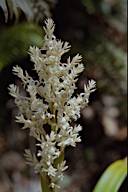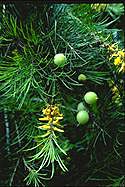

 |
Australian National Botanic Gardens
|
 |
A weekly news sheet prepared by a Gardens' volunteer.
Numbers in square brackets [] refer to garden bed Sections.
Plants in flower are in bold type.
14 January 2005
 |
|
Helmholtzia glaberrima
- click for larger image
|
Kangaroo Paws are brilliant throughout the Gardens as are those along Banks Walk. Anigozanthos ‘Bush Haze’ [Section 210] with its hazy red and greenish ‘paw’ flowers tipping the long stems and Anigozanthos ‘Bush Sunset’ [Section 210], so well named. At the base the brilliance of Scaevola ‘New Blue’ [Section 210] is a bright ground-cover. Behind the bulky Macrozamia moorei, the red buds cover the top of a cultivar, Eucalyptus ‘Wildfire’ [Section 174] which can better be seen from the lower path.
Take the stairs to the lower boardwalk into the Rainforest Gully absorbing its air and beauty to the next ascending stairs where the path is edged with the Stream Lily, Helmholtzia glaberrima [Section 144,145] with long spikes of soft pink floral plumes. Up the rise to the left, the red flowers on the small tree are those of the Dorrego Waratah, Alloxylon pinnatum [Section 148].
The next part of this walk is on the far side of the Sydney Flora Gully. On the way particularly note an attractive spreading tree, a Dwarf Apple, Angophora hispida [Section 22], with large dense cream flower balls.
 |
|
Persoonia pinifolia
- click for larger image
|
From the narrow path on the far side of the Sydney Gully the yet dwarf Prostanthera densa [Section 191F] is covered with pink trumpet flowers. Crowea exalata [Section 191K] is a larger neat shrub with pink star-flowers while opposite, Banksia oblongifolia [Section 191F], although drought affected, is colourful with red new growth. The Smooth-barked Apple, Angophora costata subsp. costata [Section 191F] is a tall tree with satin tan trunk and high up is covered with cream flowers – low down there is one branch with flowers at eye level. An old Geebung, Persoonia pinifolia [Section 191F] has pine-like foliage and yellow terminal flower spikes from the pendulous branches. Beside the seat the suckering Dampiera stricta [Section191F] bears blue flowers while opposite, the old Banksia serrata [Section 191W] with tough ripply bark, shows off its many orange-grey flower spikes. The gully slope is dense with the River Rose, Bauera rubioides [Section 191W] a dense, spreading shrub displaying soft pink downturned flowers. Epacris longiflora [Section 191F] bears the last few of its slim red and white tubular flowers along its stringy branches, and the ground-cover, Hibbertia pedunculata [Section 191F] bears its bright yellow flowers over the dark dense foliage.
Edging the road to the Glass house, Ceratopetalum gummiferum ‘Christmas Snow’ [Section 191C] is mostly covered with tiny white flowers but now is showing some renowned sprays of reddened swollen calyces which follow those white flowers. Orchids in the hot humid glass house include the splendid orange and white pendent sprays of the exotic Dendrobium thyrsiflorum from Asia, one of the few non-native plants displayed in our collection.
Returning to the Sydney Gully, follow the path across the road to view the scene of Christmas Bells, Blandfordia grandiflora [Section 191C], so picturesque with sprays of large waxy orange-red flowers with yellow tips, like bells on top of long stems. Continue along this path to a group of Flannel Flowers, Actinotus helianthis ‘Federation Stars’ [Section 191L] with velvety grey foliage and soft white daisy-like flowers. The Main Path is worth following back to the café or car-park.
Really was worth the walk … Barbara Daly.